- The Madman With Nuclear Weapons is Donald Trump, Not Kim Jong-un - Mehdi Hasan (The Intercept)
- “Fire & Fury” or “Shock and Awe”: it is always the start of a Quagmire - Juan Cole (informed Comment)
- In Guam, the Gravest Threat Isn’t North Korea — It’s the United States - Leilani Ganser (Foreign Policy in Focus)
The Madman With Nuclear Weapons is Donald Trump, Not Kim Jong-un
By Mehdi Hasan
August 9, 2017
For once, Donald Trump has a point. “We can’t let a madman with nuclear weapons let on the loose like that,” he told Philippines President Rodrigo Duterte, according to the transcript from their bizarre phone conversation that was leaked to The Intercept in May.
The madman the U.S. president was referring to, of course, was North Korean dictator Kim Jong-un. The madman the rest of us should be worried about, however, is Trump himself, who — lest we forget — has the sole, exclusive and unrestricted power to launch almost 1,000 nuclear warheads in a matter of minutes, should he so wish.
Most nonproliferation experts — as well as former President Jimmy Carter and a number of former Pentagon and State Department officials, both Republican and Democrat — agree that the brutal and murderous Kim, for all his bluster, is not irrational or suicidal, but bent on preserving his regime and preventing a U.S. attack. Nuclear weapons are a defensive, not an offensive, tool for the North Korean leadership — which, as Bill Clinton’s defense secretary William Perry observed on Fox News in April, may be “ruthless and … reckless” but “they are not crazy.”
Got that? Kim is bad, not mad.
The same cannot be said of The Donald. Think I’m being unfair? In February, a group of psychiatrists, psychologists and social workers wrote to the New York Times “that the grave emotional instability indicated by Mr. Trump’s speech and actions makes him incapable of serving safely as president.” In April, another group of mental health experts told a conference at Yale University’s School of Medicine that Trump was “paranoid” and “delusional” and referred to the president’s “dangerous mental illness.”
Is it any wonder then that so many recent reports suggest that South Koreans are more worried about Trump than they are about the threat posed by their hostile and paranoid neighbor?
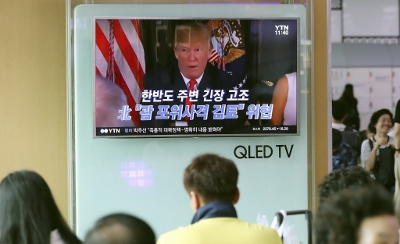
Consider Trump’s reaction this week to a confidential U.S. intelligence assessment — leaked to the Washington Post — that the DPRK is now able to construct a nuclear warhead small enough to fit inside its missiles. “North Korea best not make any more threats to the United States,” the president declaimed, in response to a reporter’s question at his Bedminster Golf Club on Tuesday. “They will be met with fire and fury like the world has never seen. He has been very threatening beyond a normal state. And as I said, they will be met with fire, fury and frankly power the likes of which this world has never seen before.”
How is this not an unhinged response from the so-called Leader of the Free World? In May, he said he would be “honored” to meet with Kim and praised him as a “pretty smart cookie.” In August, he took a break from his golfing vacation to casually threaten nuclear annihilation of Kim’s country (not even on the basis of any aggression by the DPRK, incidentally, but only their “threats”).
Does Trump understand the difference between escalating and de-escalating a nuclear crisis? Listen to Republican Senator John McCain, who has never met a “rogue nation” he did not want to bomb, invade or occupy. “I take exception to the president’s words,” McCain said on Tuesday, adding: “That kind of rhetoric, I’m not sure how it helps.”
I mean, just how crazy do you have to be to advocate a preemptive nuclear strike that even McCain cannot get behind?
Trump has form, though, when it comes to loose talk about nukes. During the presidential campaign, in August 2016, MSNBC host and ex-Republican congressman Joe Scarborough revealed that Trump, over the course of an hour-long briefing with a senior foreign policy adviser, had asked three times about the use of nuclear weapons. At one point during the meeting, according to Scarborough, the then-GOP presidential candidate asked his adviser, “If we had them, why can’t we use them?”
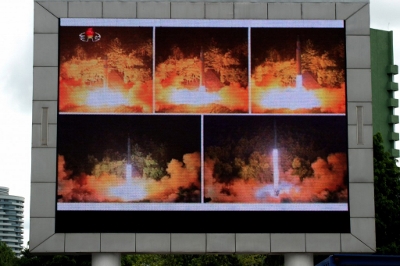
To be so blasé, enthusiastic even, about the deployment of the ultimate weapon of mass destruction is a stark indicator of Trump’s childishness, ignorance, belligerence, and, yes, derangement. Here is a president who is impulsive, erratic, unstable; whose entire life and career have been defined by a complete lack of empathy. Remember his strategy for defeating ISIS? “Bomb the shit out of ’em” and “take out their families.”
So do you think civilian casualties were on his mind when he issued his “fire and fury” warning? Come. Off. It.
Listen to McCain’s fellow Republican super-hawk Senator Lindsay Graham. “If there’s going to be a war to stop [Kim], it will be over there,” Graham told NBC’s Matt Lauer last week, recounting a recent conversation he had with the president. “If thousands die, they’re going to die over there. They’re not going to die over here — and he’s told me that to my face.”
“This is madness,” Kingston Reif, a nuclear disarmament specialist at the Arms Control Association, tweeted in response to Graham’s re-telling of Trump’s remarks. “Unhinged madness.”
Remember that 72 years ago today, the United States dropped the second atomic bomb on Japan, killing around 39,000 people in Nagasaki. Three days earlier, the first A-bomb killed around 66,000 people in Hiroshima. But a nuclear war on the Korean peninsula would make those strikes on Hiroshima and Nagasaki look like pinpricks. Experts say even a conventional war between the U.S. and the DPRK could kill more than 1 million people; a nuclear exchange, therefore, might result in tens of millions of casualties. Trump’s national security adviser, H.R. McMaster, has admitted that such a preemptive strike by the U.S. would be a “humanitarian catastrophe.”
Does the president care? Graham doesn’t seem to think so. Trump’s former ghostwriter Tony Schwartz, who spent 18 months in his company while working on The Art of the Deal, has called the president a “sociopath.” In fact, one quote more than any other stood out from Schwartz’s much-discussed interview with the New Yorker in July 2016 and, perhaps, should keep us all awake at night. “I genuinely believe that if Trump wins and gets the nuclear codes,” said Schwartz, “there is an excellent possibility it will lead to the end of civilization.”
We can’t say we weren’t warned.
[Mehdi Hasan is an award-winning British columnist, broadcaster, and author based in Washington, D.C. He hosts UpFront on Al Jazeera English and has interviewed, among others, Edward Snowden, Hamid Karzai, Ehud Olmert, and Gen. Michael Flynn. He is also the author of two books — a biography of former U.K. Labor Party leader Ed Miliband and an e-book on the financial crisis and austerity economics. Mehdi has written for the New York Times, the Washington Post, The Guardian, and the Times of London, among others, and is the former political director of the Huffington Post U.K. and a contributing editor to the New Statesman. He has been included in the annual list of the 500 most influential Muslims in the world and named as one of the 100 most influential Britons on Twitter.]
“Fire & Fury” or “Shock and Awe”: it is always the start of a Quagmire
By Juan Cole
August 9, 2017
If we weren’t talking about two nuclear-armed states with unhinged leaders, the war of words between the US and North Korea would be hilarious. Trump’s threat Tuesday that “”North Korea best not make any more threats to the United States. They will be met with fire and fury like the world has never seen” was empty rhetoric and the government of Kim Jung-un knows it, which is why they immediately teased Trump that they were going to hit Guam with a missile strike. The counter-threat was just as absurd as the initial one.
This sort of over-heated rhetoric is hardly unprecedented and always weakens the United States.
North Korea is a country with a $17 billion gross domestic product (nominal) and a population of 25 million. I’m sure it has its virtues, but military weight in world affairs isn’t one of them. It is in a league with Nepal, Gabon and Iceland economically. Population-wise it is in the same league as the Cameroons and Madagascar. The US has a population of 320 million and a GDP of $18.5 trillion.
When I heard the phrase “fire and fury,” I couldn’t help thinking of George W. Bush’s threat of “shock and awe” against Iraq in March of 2003.
The threat was intended to convince Saddam Hussein and other embers of the Iraqi elite to flee the country without preconditions.
It did not work. The US failed to find Saddam, and failed to decapitate the regime.
The American Air Force did rain down destruction on Baghdad, but Baghdad did not surrender.
The army was sent in, grunts on the ground having to fight Iraqi armor and other units. Increasingly the military realized it had been duped by W.’s rhetoric. As Iraqi soldiers discarded their uniforms the better to engage in a guerrilla war, one general got into trouble with the highly scripted White House when he admitted that this was not the war they had gamed for.
The shock and awe that was supposed to make Saddam surrender without a shot, and to cow the Iraqis into submission, Instead the US was drawn into an Iraqi quagmire that continues to this day.
When they start talking shock and awe in Washington, friends, it is time to hunker down for the long haul.
[Juan Cole is Richard P. Mitchell Collegiate Professor of History at the University of Michigan. For three decades, he has sought to put the relationship of the West and the Muslim world in historical context. His most recent work is The New Arabs: How the Wired and Global Youth of the Middle East Is Transforming It (Simon & Schuster, June, 2014). He has been a regular guest on PBS’s Lehrer News Hour, and has also appeared on ABC Nightly News, Nightline, the Today Show, Charlie Rose, Anderson Cooper 360, Countdown with Keith Olbermann, Rachel Maddow, the Colbert Report, Democracy Now! and many others. He has written widely about Egypt, Iran, Iraq, and South Asia. He has commented extensively on al-Qaeda and the Taliban, the Iraq War, the politics of Pakistan and Afghanistan, and Iranian domestic struggles and foreign affairs. Cole commands Arabic, Persian and Urdu and reads some Turkish, knows both Middle Eastern and South Asian Islam. He lived in various parts of the Muslim world for nearly 10 years, and continues to travel widely there. A bibliography of his writings may be found here.]
Related video:
AP: “Trump: NKorea Will Be Met with ‘Fire and Fury'”
Watch here.
In Guam, the Gravest Threat Isn’t North Korea — It’s the United States
The United States is using this Pacific colony as its own private firing range.
By Leilani Ganser
August 3, 2017
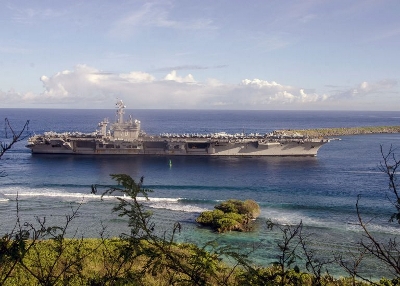
This past Fourth of July, while I listened to the fireworks outside the Capitol building, my phone started buzzing with news alerts. North Korea, they said, had tested an intercontinental ballistic missile. Headlines emphasized that it could supposedly reach Alaska.
But much closer than Alaska is the tiny island of Guam — a U.S. colonial possession in the Pacific long exploited as a military base. My grandmother was born there, and much of my family remains. At just 30 miles long and 8 miles wide, Guam is often called “the unsinkable aircraft carrier,” as a third of the island is covered in military bases.
That’s long made it a strategic target for enemies of the United States. In fact, during the Cold War, it was said that the Soviets were the only ones who could point out Guam on a map. For as long as the West has been aware of Guam’s existence, it’s been a target.
During World War II, while my grandmother still lived there, the Japanese occupied Guam and terrorized the indigenous Chamoru population, rounding them up and herding them into concentration camps. In the Manenggon camp, 18,000 Chamorus were interned and surrounded by machine guns set up by the Japanese soldiers for a planned massacre.
Today, with the Japanese long gone and the Soviet Union dissolved, the island still faces a battery of live-fire military ammunition with no foreseeable end. But the immediate danger doesn’t come from North Korean missiles. It comes from the United States military, which freely uses the Pacific territory as its own private firing rage.
While tourist ads depict the South Pacific as a tranquil safe haven, that tranquility is pierced by the roars of B-52 bombers and submarine water-to-shore artillery blasts. For as long as the United States has maintained Guam as a colony, it has been a simulated warzone.
It’s not simply the military firing weapons that can make life difficult for locals, however. The issue is often the presence of the military itself.
With military bases come extreme pollution, the occupation of sacred lands, and what some scholars describe as an invisible public health crisis. While the primary argument for these bases is national security, there are countless examples of these bases damaging the health and security of the local population.
Over the years Guam has been home to nuclear weapons, mustard gas, and countless other carcinogens. In the 1980s, the Navy discharged radioactive water into a harbor my family has used for fishing. This increased exposure to radioactivity is linked to toxic goiters, a major contributor to thyroid issues which are now abundant in the local population. Multiple wells accessing the island’s one aquifer have had to be shut down due to chemical contamination from areas under or adjacent to these military bases.
Indigenous groups have largely led the fight against military pollution. The largely Chamoru-led We Are Guahån — Guahån is the indigenous name for the island — has worked for years to engage and mobilize the local community to prevent further military buildup. Their efforts are fundamental to the mission of a sustainable Guam.
In this, they’re drawing inspiration from activists on Puerto Rico — which, like Guam, is a U.S. imperial acquisition from the Spanish-American war whose strategic location has subjected it to exploitation from the U.S. military. There, residents of Vieques led protests in 1999 that ultimately resulted in the shutdown of the Navy’s base on the small island, which lies off the coast of Puerto Rico proper. Unfortunately, the lasting consequences of these bases, active or abandoned, are faced by locals daily.
Vieques was a live fire training site for the Navy for over 60 years and has since become one of the single sickest populations in the Caribbean. Along with skyrocketing rates of cancer, the people living on Vieques have a seven times higher risk of diabetes and eight times higher risk of cardiovascular disease than the rest of Puerto Rico.
The Navy has since admitted to the use of heavy metals and chemical agents on Vieques, including depleted uranium and Agent Orange, but denies any link between their use and the health of the residents. But Arturo Massol Deyá , a professor of microbiology and ecology at the University of Puerto Rico at Mayagüe — and the only independent scientist allowed to conduct research on Vieques — continues to find high concentrations of heavy metals in his samples of vegetation, crabs, lagoons, and other local food sources.
In both Guam and Puerto Rico, such pollution is devastating to the ecology of the local areas — and to any argument that the bases encourage economic growth for the impoverished local populations. In fact, they restrict the indigenous populations’ ability to engage in traditional means of subsistence and poison the resources locals rely on for self-sustainability.
In places like these, plans to expand U.S. military facilities — which could soon cover 40 percent of Guam, if plans initiated during the Obama administration go through — are a far greater threat than any missiles from Korea.
These bases of empire are an affront to self-determination and a reminder of our families caught in the crossfire of Western wars for “rights” and “freedom” that my grandmother and my family should have, too.
This article is a joint publication of Foreign Policy In Focus and In These Times.
[Leilani Ganser is an indigenous rights organizer and political science major at Reed College. She’s a Next Leader at the Institute for Policy Studies.]

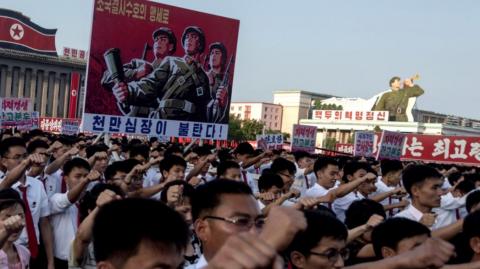
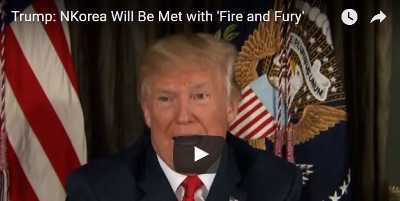
Spread the word